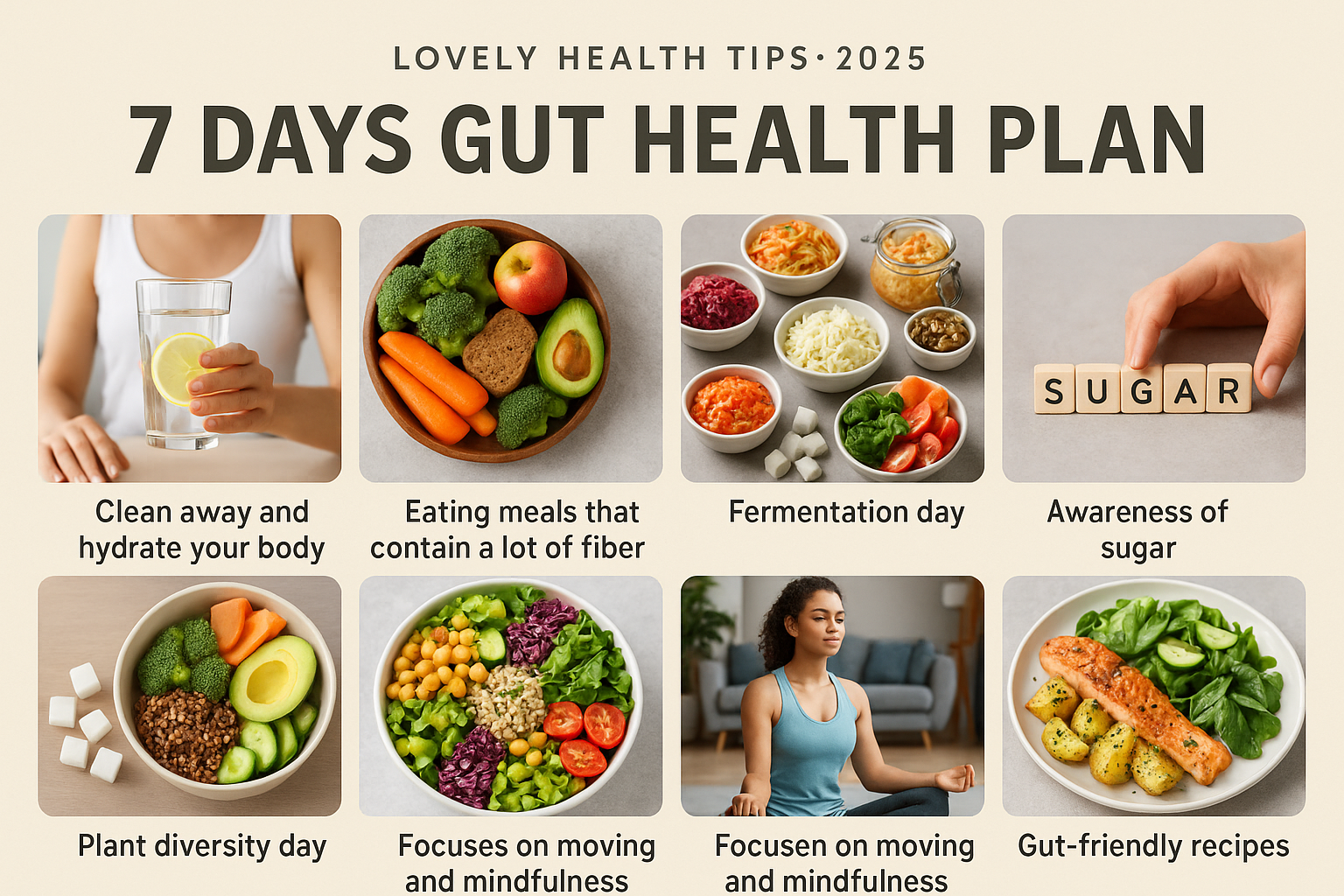Last Updated on October 21, 2025 by
A quick and easy way to help digestion at any age & gut health plan
In the last few years, the gut microbiome has become more important in health and wellness. As per study, it is alarming that the wellbeing of our gut affects our digestion, defense system, mental energy, mood & prevention of long-term diseases. A lot of people ignore that gut health affects both adults & children. Sometimes children take antibiotics, we also eat more processed foods than we want or we feel simply bloated, sluggish or tired.
A microbiome reset may be an excellent solution to such cases. The plan is made for the families who have not cared for it. A plant-based diet is not meant to replace a detox, cleanse or starving. In fact, it feeds our digestive tract by adding the good bacteria in the body making us feel good later on.
Why should the gut be cleaned and reset?
Gut microbiome contains many different types of bacteria, fungi and microbes. Having a healthy gut supports the following:
- Efficient digestion
- Stronger immunity
- Having emotions that are stable and a well-functioning brain
- Getting more nutrients from food
- Reduced inflammation
Because of sugar, carbohydrates, antibiotics & stress, modern living may cause the immune system to weaken. Children are more at risk for gut imbalances which can show up as problems like:
- A lot of stomach pain or problems with constipation
- Recurrent infections
- Someone could experience eczema or skin rashes.
- Swinging emotions or be getting annoyed
- Food intolerances
Fixing the family’s mealtimes for just one week can have them healthier, with improved digestion, a boost of energy.
Before you start the reset, here are the major principles:
- Avoid any strict diets — Include food, don’t limit it. Focus on including more fiber, fermented products and liquids in your diet.
- Fiber Counts : Vegetables and fruits rich in fiber nourish the bacteria that maintain good health to the intestine.
- Fermented foods to be Included — Eat yogurt, kefir, sauerkraut and kimchi since they have live probiotics.
- Intake of Sugar Should be Limited — Sugar is not forbidden but it gives fuel to unhealthy bacteria and yeast.
- Regular exercise: Working out and sleeping well on a daily basis promote a wide range of microbes.

We can look at above topic day by day.
1. Day 1 – Detox & Hydrate body:
Aim: Flush out waste from the body an action plan.
- For the first drink of the day, have either warm water plus lemon (for parents) or water with a little orange juice (for kids).
- Have your breakfast with cooked oatmeal, chia seeds and some berries and yogurt.
- Have less soda or sugary juice and choose water or fresh juice that is not very sweet.
- Have your lunch with a bowl of lentil soup, some whole grain bread and carrot sticks for delicious fiber.
- Do a post-dinner quick walk with your family or incorporate a stretch.
Drinking enough water improves bowel function and supports the gut bacteria.

2. Day 2 is primarily about eating meals that contain a lot of fiber.
The aim is to provide more prebiotic fiber for good gut bacteria. Here is the Action Plan.
- Think about including foods high in inulin, pectin and resistant starch, for example, bananas, onions, garlic, oats, apples, sweet potatoes.
- All ingredients are whole grain bread and the toppings are slices of avocado and tomatoes.
- A snack can be apple slices spread with almond butter.
- A typical dinner would be quinoa, garlic-roasted vegetables and either grilled chicken or tofu.
We may note that “Prebiotics are the nutrient source most favored by gut bacteria.”
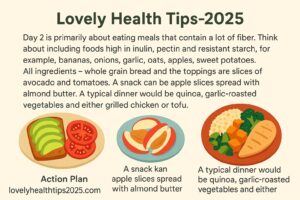
3.️ Day 3 is for fermentation day
Goal: Eat fermented foods that include live probiotics. Here is some Action Plan.
- Try to always include one portion of fermented food like yogurt, kefir, sauerkraut, miso, kimchi or tempeh with meals.
- Making a breakfast shake is simple by combining kefir, banana and berries.
- Sandwich at lunch consisting of sauerkraut, cheese and whole grain bread that had been grilled.
- Miso soup and kimchi fried rice are tasty dishes to serve with the rest of the meal (kind choices for the little ones).
- Fermented foods are also introduced in small quantity in food or drinks especially in small children.
First, use a little and then slowly increase amount.
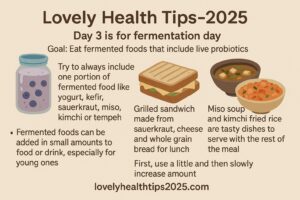
4. Awareness of Sugar
Review your foods so you can decrease sugar and completely eliminate any artificial sweeteners. Action Plan:
- We may choose the whole fruit or nuts not by taking sweet taste cereals or granola bars for snacks.
- Mark foods with high-fructose corn syrup, sucralose, aspartame or “natural flavors” as products to avoid.
- Try mixing Greek yogurt without sugar, fruit and a small amount of honey as your first meal.
- Try a lunch wrap with hummus, lettuce and some thin slices of cucumber and carrots.
- A cup of popcorn that was air-popped or some nuts (of mixed nuts).
Sugar and artificial sweeteners tend to boost harmful bacteria in our digestive system and interfere with the diversity of our healthy microbiome.

5. Day-5 is set aside as Plant Diversity Day.
Try to eat 10 or more different plants during a single day. ACTION PLAN
- Calculate here the number of plant-based meals you eat now.
- Make a smoothie out of spinach, banana, blueberry, flax and oats.
- Brown rice, beans, greens, tomato, avocado and pumpkin seeds mixed in a grain bowl for the lunch.
- Dinner with a plate of pasta with homemade veggie sauce (zucchini, mushrooms, bell pepper, tomato).
- Eating a range of foods promotes a greater range of beneficial bacteria in the gut.
Giving a variety of fiber sources is always good for them.
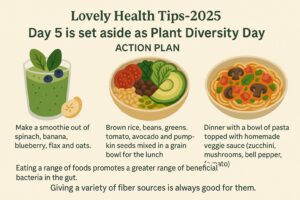
6. Mobility exercises and awareness exercises make up the Day 6 workout:
The goal is to build connection between the gut and brain through regular exercise, good habits and reducing stress. Following the action plan:
- Do at least 30 minutes of movement such as a family dance, bicycling, yoga or walking through nature.
- You could include some heavy breathing or journaling about things before bed.
- Try to eat each bite 15–20 times and focus on the meal.
- When stressed, the lining of your gut might weaken which also could reduce the number of good bacteria present.
Being calm helps the digestive system to function properly.
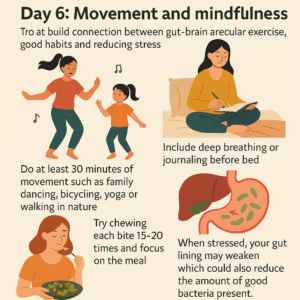
7. Gut-Friendly Recipes
Our goal is to encourage gut health by enjoying a meal with those foods & remembering the experiences from the week. Actions to take:
- Give your family a warm stack of whole grain pancakes, top them with kefir yogurt and add some fresh fruit compote.
- Dinner: Give everyone the chance to pick from beans, avocado, salsa, onions and other veggies.
- Advice from the gut: Explaining how meals impact the body helps kids select better options long time.

Helpful Advice to Care for Your Gut Over the Long Term
- Changing your food choices every week helps keep diverse the microbiome.
- To make children willing to eat other meals, involve them in purchasing groceries and cooking.
- Try a fermented food weekly such as blending kefir into smoothies, using yogurt in dips or having kimchi on top of rice.
- Have some high-fiber foods available for snacks such as nuts, seeds, popcorn, raw vegetables and dried fruits.
- Do not take antibiotics unless doctor recommends them and always finish any antibiotic course as told by them.
Promote good gut health for kids. (Gut Health Plan)
Their digestive systems are not fully formed yet which makes their microbiomes extra sensitive. It is a mild plan mostly based on food, so most healthy children can use it.
However, if any of these are happening to your kid:
- A food problem identified as an intolerance or an allergy
- Problems in digestion such as IBD and celiac
- Since the last 30 days, the type of antibiotics used
- Those with frequent problems with constipation or diarrhea
Asking to a pediatrician or registered dietitian before such changes in diet is recommended.
Concluding remarks: A little step for gut health
- It’s possible to reset the microbiome in your family by changing your simple daily habits, not by spending lots of money. So, it is about picking out foods that help your well-being and bring you closer to your family.
- Within a short time, you might think you’re feeling better, getting less stomach pain, sleeping more or having more energy. All of these benefits eventually build on each other. Having a healthy gut helps every family member live healthier.
- So, start today with sustainability, by having a tasteful snack, enjoying a colorful meal and slowly savoring each bite. Giving your family healthy whole foods will make your gut feel good and them happy.
Suggested Steps for Resetting your family’s Microbiome in 7 days
- Starting Day 1 — Good clean and proper hydration.
- Take a warm lemon water or dilute juice at the first thing in the morning
- Eat a mix of oatmeal, chia seeds, berries and yogurt for breakfast
- Reduce sugary drinks to drink mostly water and herbal teas.
- Get yourself or your family to take a quick evening stroll after dinner.
2. As much as possible, try to eat high fiber foods on Day 2
- Include foods with fiber such as oats, apples and sweet potatoes.
- Have apple slices spread with nut butter.
- Eat more lentils, beans or whole grains with your meals.
- Incorporate them where you can into your food
3. Day 3 is the day of the fermentation:
- Eat 1 fermented food per week (yogurt, kefir or sauerkraut are good choices).
- You can find miso soup, kimchi or tempeh at most stores.
- Give children only small amounts at first.
4. Day-4: be aware of how much sugar you are having throughout the day.
- Skip sugary cereals and packaged foods such as chips, crackers and cookies.
- Check the list of ingredients for sugars and sweeteners on packaged foods.
- If you have to drink soda, always go for fruit-infused water.
- Eat whole fruits.
5. The fifth day focuses on many different plant species
- Try to eat at least 10 various plant foods in a day.
- By adding unusual quantities of various vegetables, make a smoothie or a bowl.
- Children need to have beans, seeds, greens and fruits in their meals.
- Count on how many plants you eat in the day.
6. Day 6 — Exercise
- Make sure that you get at least 30 minutes of exercise (walking, dancing, yoga practice)
- Major journaling or deep breathing activities might help the younger population.
- Eat with small bites and chew it well.
- Less action in the screen at night helps in promoting digestion.
7. On Day 7 Choose a Healthy meal that makes my family smile :
- Make it a point to cook food that promotes healthy gut in your family.
- Serve fermented sauces e.g. yogurt, pickles and kimchi with the toasts.
- Write about what everyone’s thoughts and feelings were during the week.
- Be proud of the minor achievements.
Reference from Havard health : 5 simple ways to improve gut health – Harvard Health
About the Author – “Mr. Bibhu Ranjan Mund”, Master in Public Health (MPH) from IIHMR University, Jaipur (Rajasthan) has experience of 18 years in Public Health activities. Through “Lovely Health Tips-2025”, we share the evidence & experienced based health & wellness guides with solutions for every day well-being. More from Author
Disclaimer
This information is suggestive only and not a replacement for medical advice. For more detail, please visit to my website as mentioned below:

